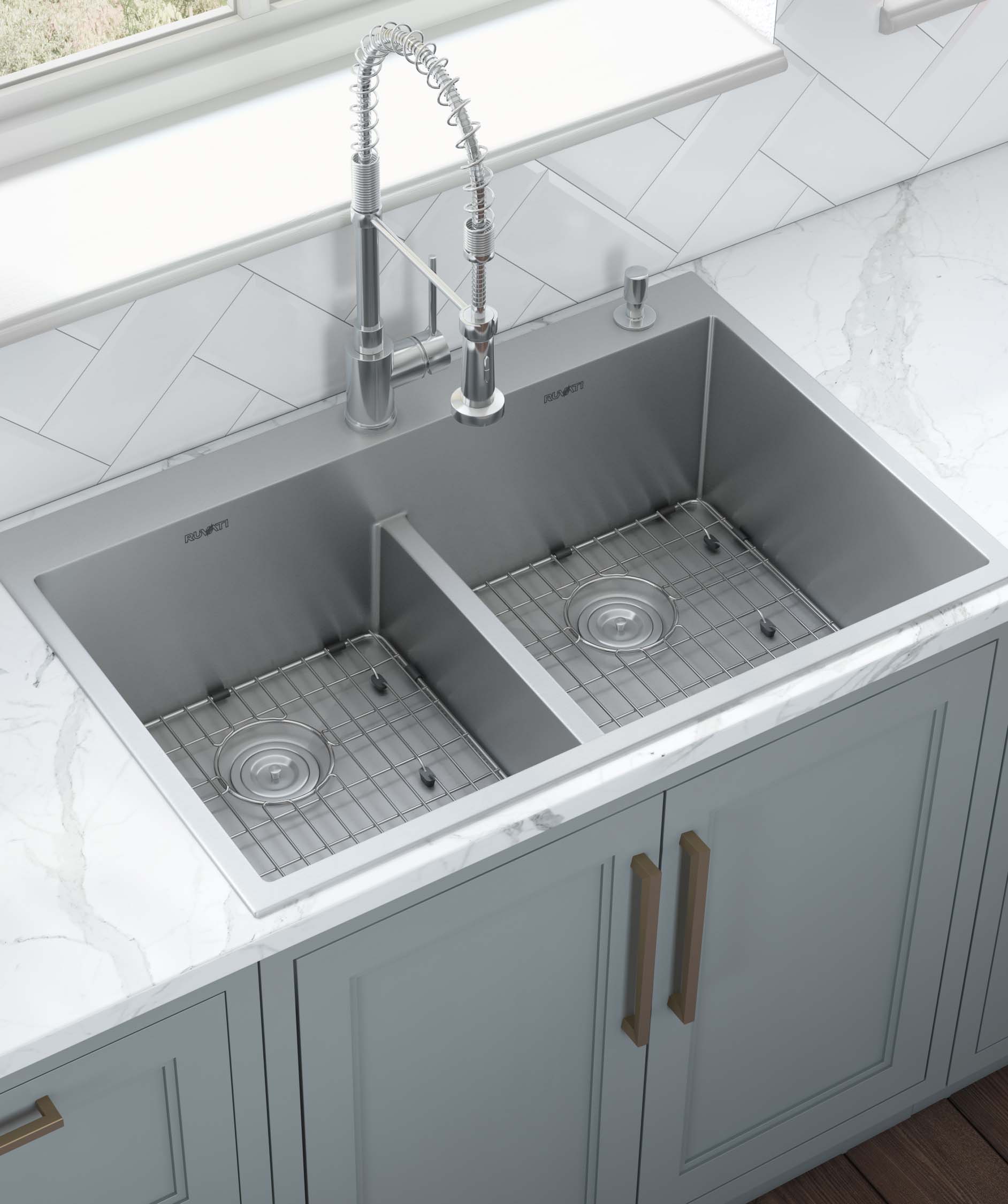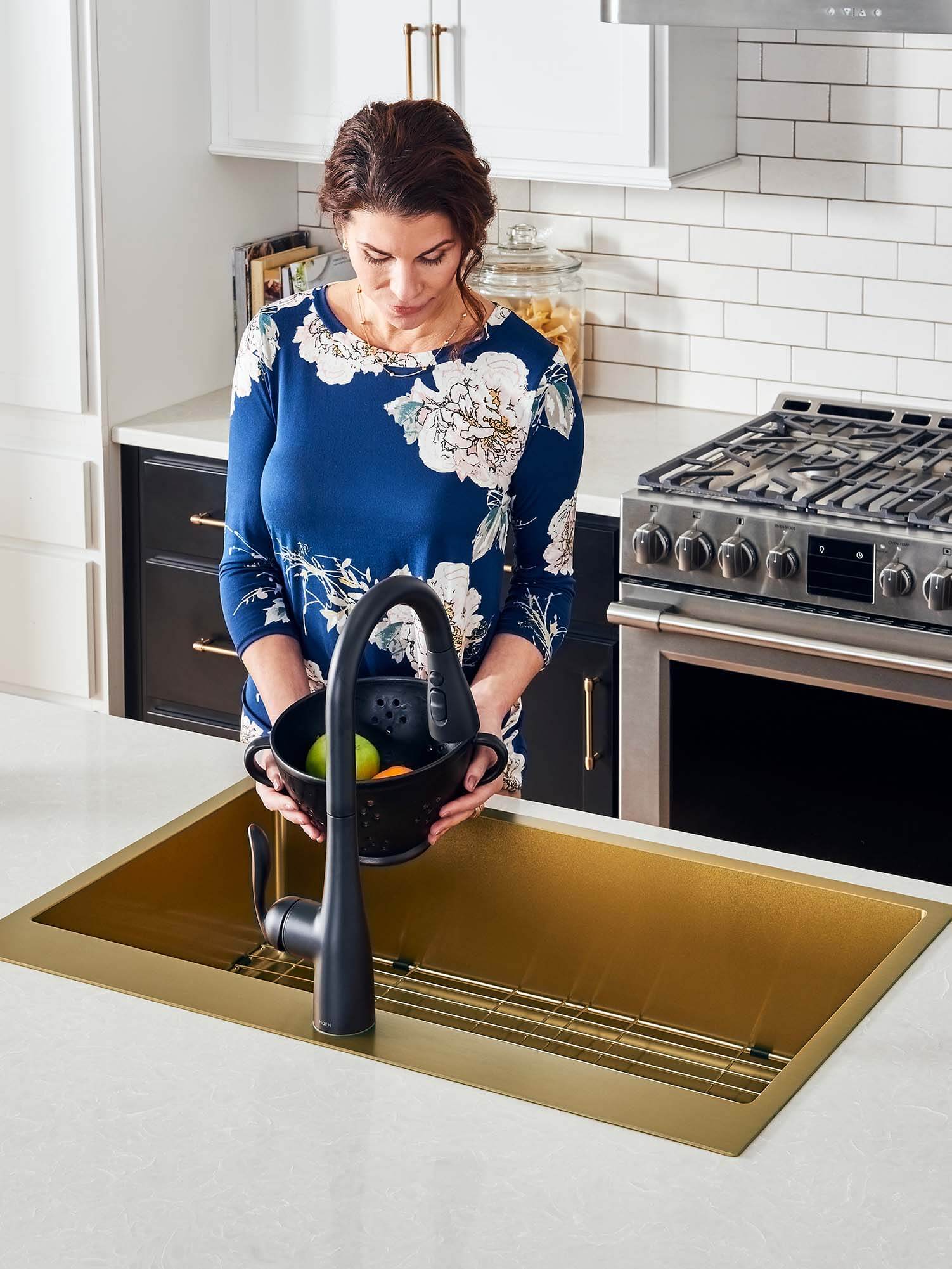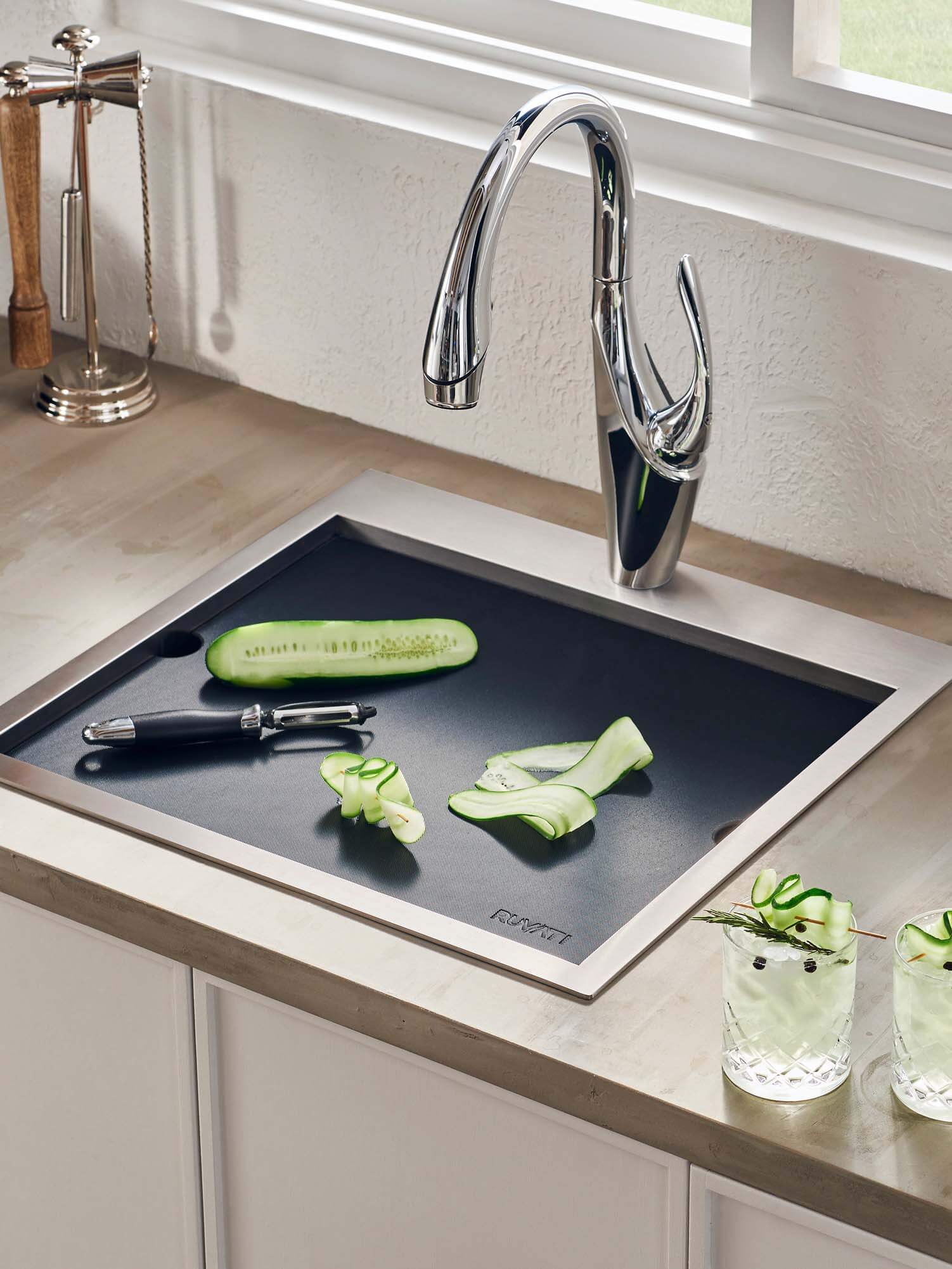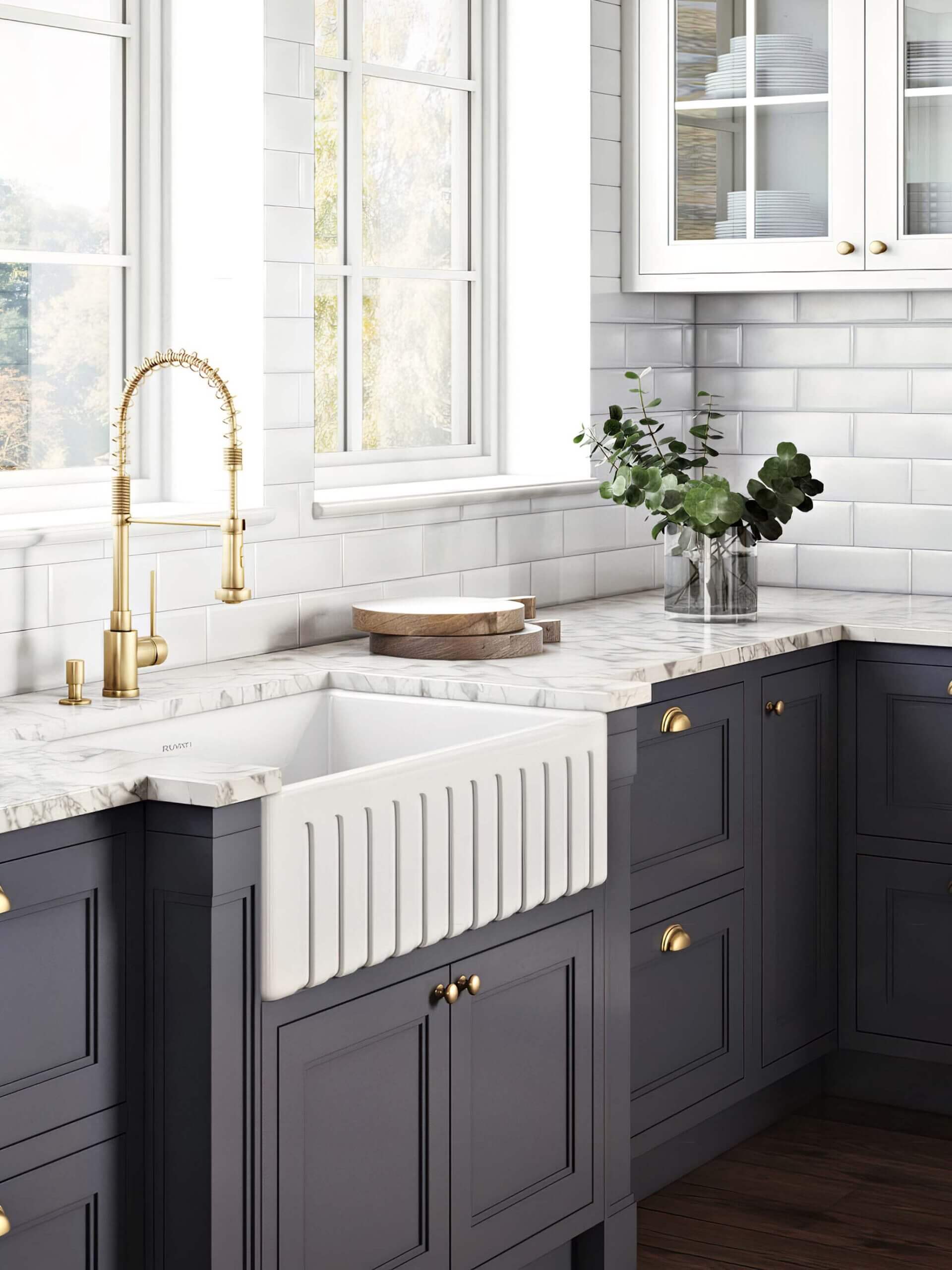Do you think your scratched stainless steel surfaces are beyond repair? Think again. You don’t have to settle for unsightly scratches marring your sleek stainless steel sink. We have innovative solutions and product recommendations to remove scratches from stainless steel items. This article will guide you in showcasing the best products for your Ruvati sink and stainless steel kitchen appliances.
Before we dive right in, it’s essential to understand how stainless steel reacts to various factors. Recognizing its susceptibility to scratches and why it’s so prone to them is necessary to tackle the issue correctly. Stainless steel, while praised for its durability and aesthetic appeal, is not impervious to damage. Its surface can quickly accumulate scratches, impacting its functionality and visual appeal. That said, let’s roll up our sleeves and get your stainless steel shining like new again.
Understanding Stainless Steel’s Vulnerability to Scratches
The vulnerability of stainless steel to scratches is primarily due to its intrinsic properties. Although this material is durable and resilient, it is susceptible to abrasion. Hard and sharp objects can easily mar it. Stainless steel’s low thermal conductivity and high expansion rate also make it prone to distortion during welding, contributing to an uneven surface that’s more susceptible to scratches.
However, the real challenge lies in preventing scratches and effectively removing them. Stainless steel scratches can be stubborn and tricky to erase, often requiring specialized techniques and products. Therefore, effectively removing scratches on stainless steel is crucial to maintaining its pristine condition.
Innovation in this area is critical, and you’ll find various cutting-edge products and techniques designed to restore the surface to its original, unblemished state. From compounds that fill and polish to tools that buff the scratches, these solutions are a testament to the relentless pursuit of perfection. Understanding stainless steel’s vulnerability to scratches and knowing how to address it enhances the longevity of your appliances and preserves their aesthetic appeal, ensuring they remain a shining testament to your taste and style.
Identifying Types of Scratches
Identifying scratches on stainless steel is relatively easy. Locating light scratches on the surface might be challenging. You may need to use something other than running your fingers carefully to detect them. These are typically superficial from daily use and cleaning and are impossible to avoid. Your appliances are bound to get scratched, whether it’s due to magnets on the fridge or utensils in the sink. Using a flashlight to reflect against the change in texture is the best way to identify scratches that are not distinct. To understand what to look for, we’ve created a list of the types of scratches that may occur to your kitchen sink.
Superficial Scratches
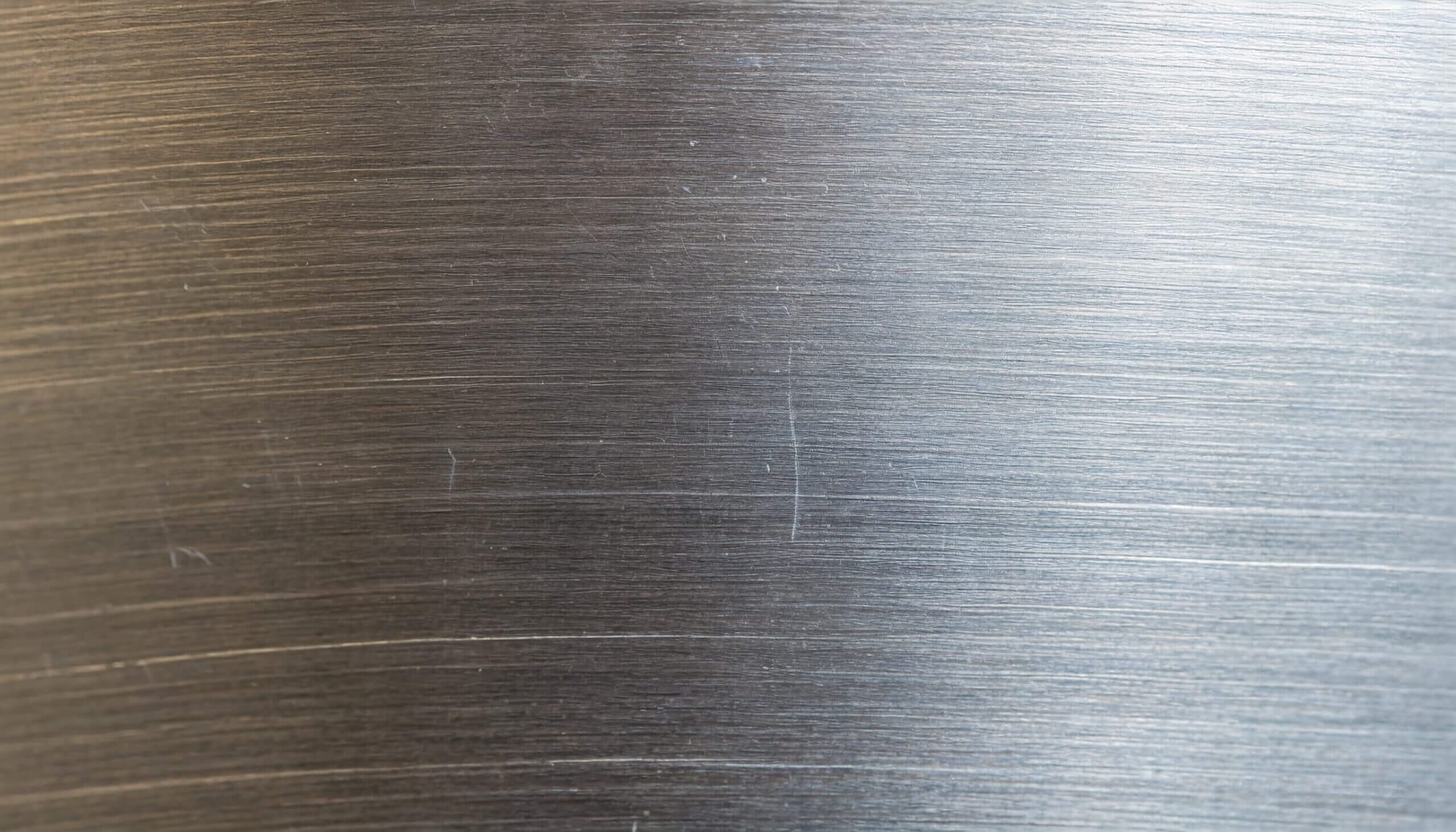
These are superficial and often result from regular cleaning or light contact with other objects. They are usually easy to buff out.
Scuff Marks
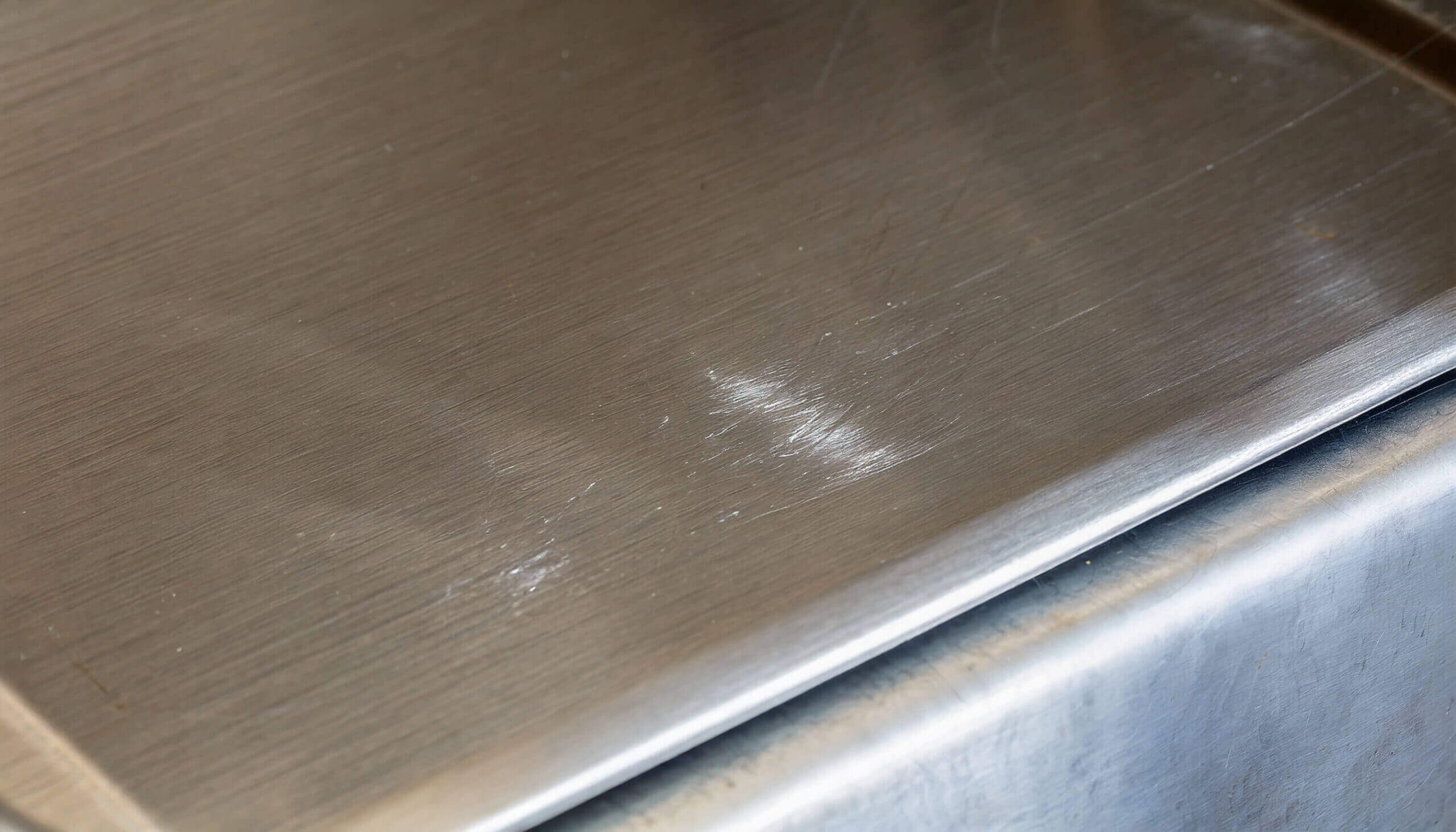
Caused by rubbing against other metal objects or abrasive materials. Scuff marks are usually superficial but can be slightly more challenging to remove. They can be buffed out quickly with the proper rubbing compound.
Brushed Finish Scratches
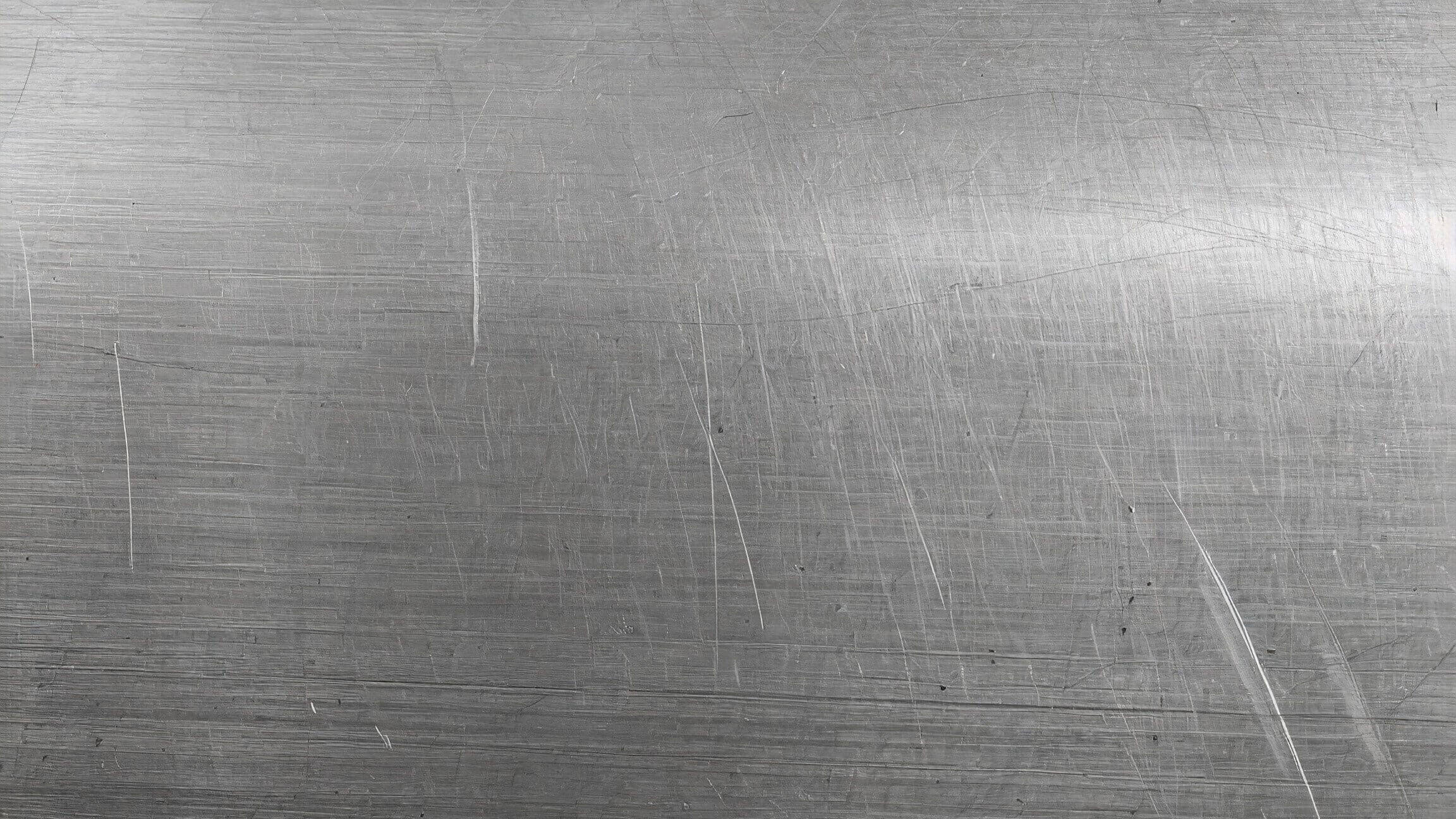
Specific to stainless steel with a brushed finish. These scratches disrupt the uniform grain pattern and can be noticeable.
Deep Scratches
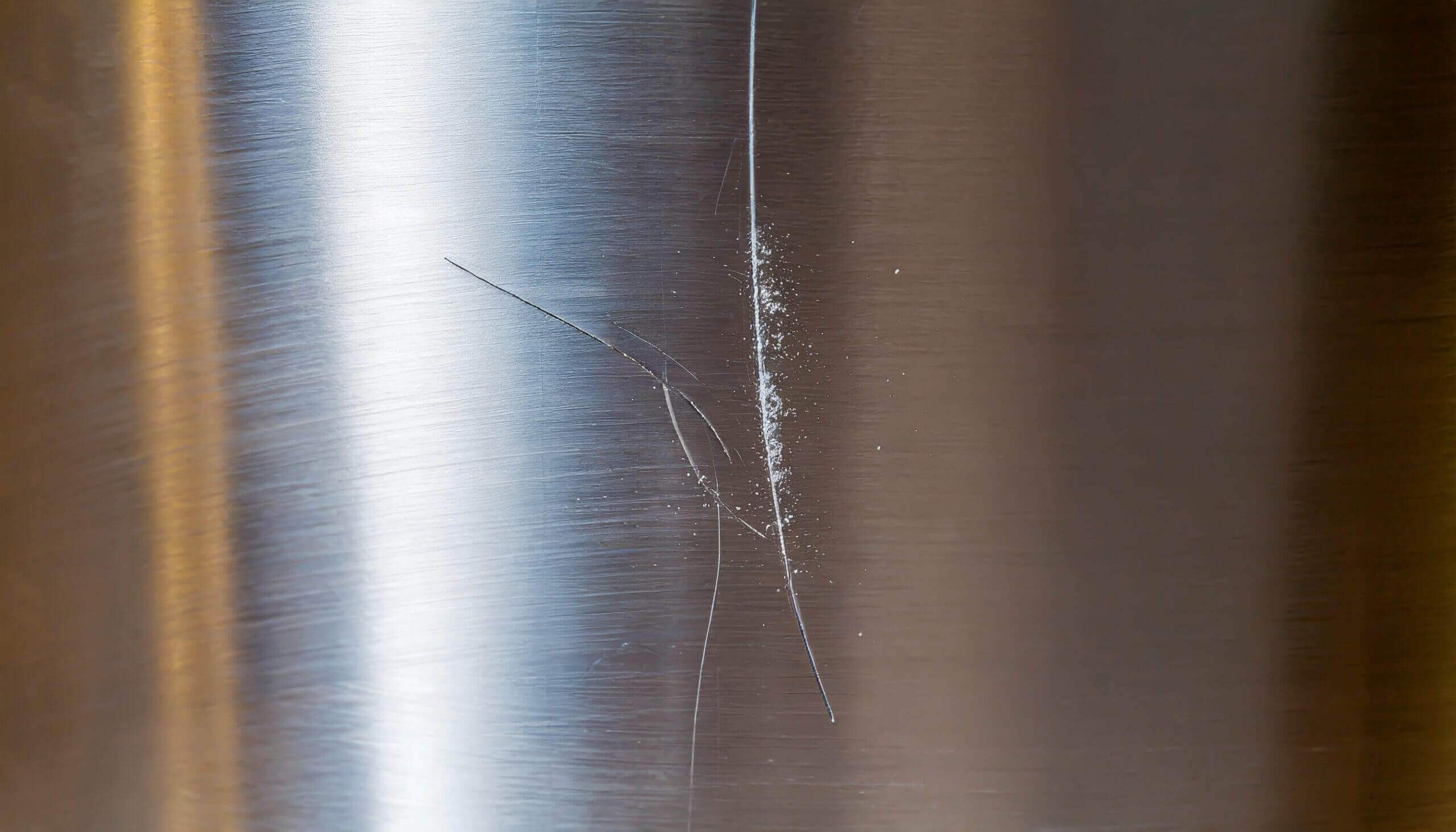
Result from heavy impact or using sharp objects on the surface. These scratches penetrate deeper into the metal and are the most difficult to remove. These scratches may require elbow grease and sandpaper ranging from 400 to 4000 grit.
Swirl Marks

Often occur from circular cleaning motions. They are a series of scratches that create a swirled pattern on the surface.
Gouges
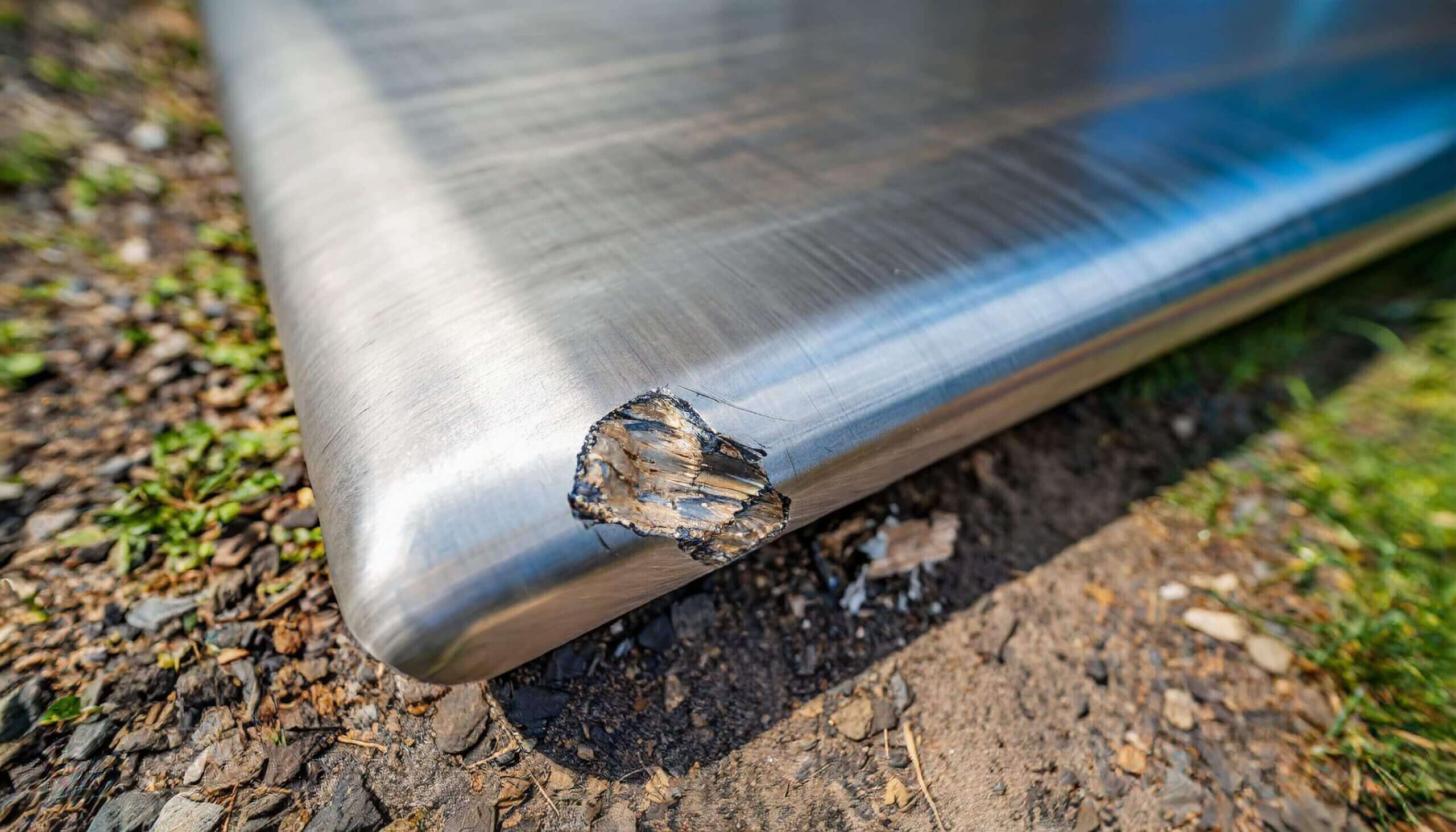
More severe than a scratch, gouges are deep cuts into the metal, often requiring professional repair or replacement of the affected area.
Rainbow Heat Stain

High heat exposure can cause a rainbow stain on stainless steel discoloration. It can leave a scuffed or scratched appearance.
Corrosion Marks
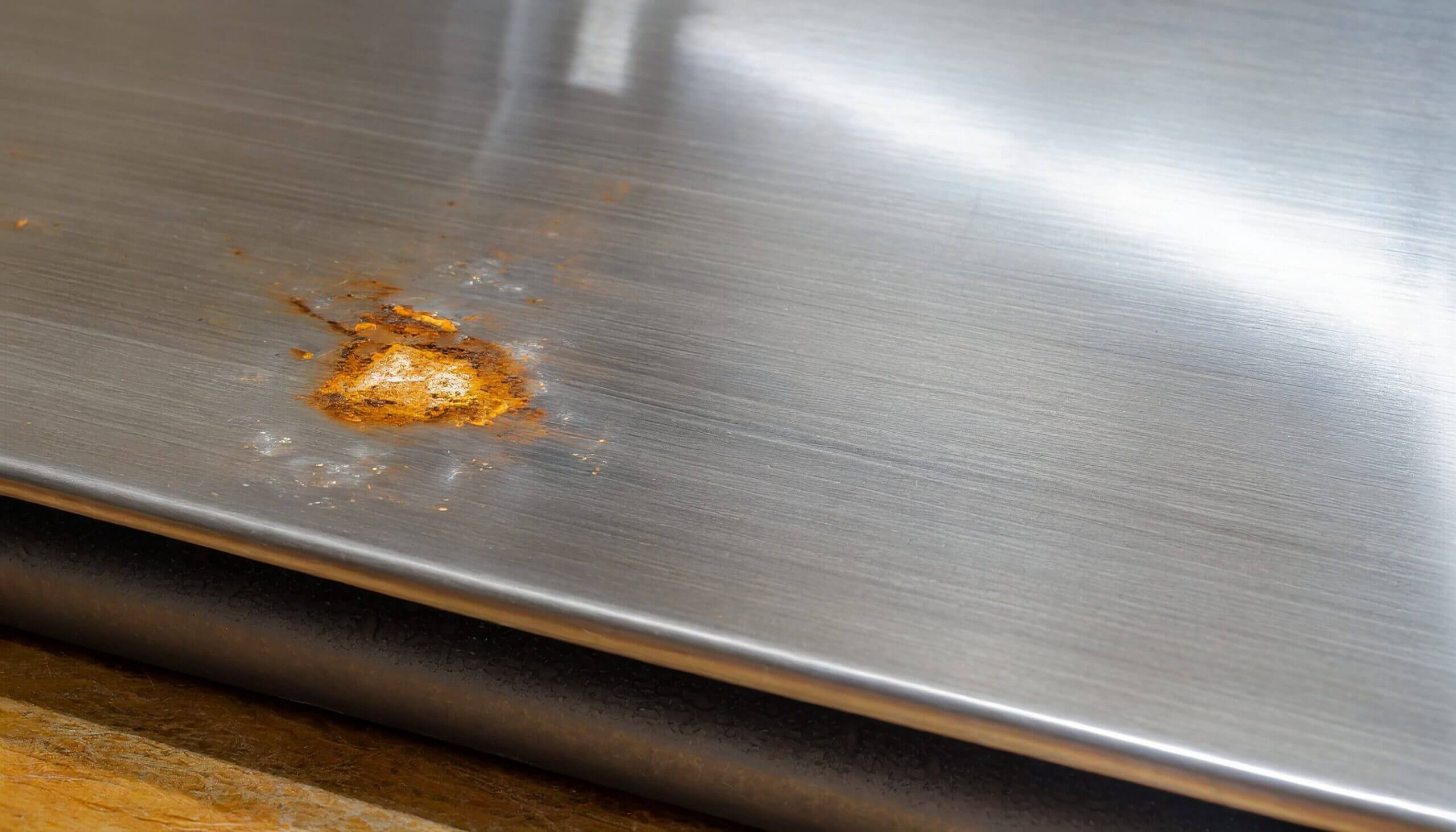
While technically not scratches, corrosion marks on stainless steel can appear as scratches or scuffs. They are often due to chemical exposure or moisture.
Products for Removing Fine Scratches and Cleaning Stainless Steel
To tackle those small scratches on your stainless steel surfaces, you’ll need a few essential tools and products designed for this specific task. Cleaning products and buffing tools specifically made for stainless steel are wise investments. It will help restore your appliances to their original shine. A scratch kit will include a specific stainless steel scratch remover. The stainless steel cleaner is essential for prepping your appliance surface, ensuring it is free from dust, grease, and any other residues that might interfere with the scratch-removal process. Cleaners like Therapy Premium Stainless Steel Cleaner or Weiman Stainless Steel Cleaner are known for their practical and safe formulas.
The scratch remover is the leading player in dealing with fine scratches from stainless steel. It’s a specially formulated compound that gently buffs the scratch with the right technique. Remember to always work along the steel grain, never against it, to prevent further damage. A clean cloth, preferably microfiber, is another critical tool in your scratch-removal arsenal. It’s used to apply the scratch remover and buff the surface once it is gone. Microfiber cloth is ideal because it’s soft, prevents further scratches, and can effectively remove the scratch compound without leaving lint behind.
Techniques to Remove Deep Scratches from Stainless Steel
When facing deeper scratches on your stainless steel, you’ll need different products and techniques to restore the surface effectively. Deep scratches in stainless steel require a more aggressive approach. Stainless steel scratch repair starts with the right tools. A stainless steel repair kit is a must-have; many are available on the market. These kits usually include everything you need, like abrasive pads and a specially formulated compound to remove deep scratches from stainless surfaces.
Next, ensure you know the direction of the grain on your stainless steel. This is crucial for effective scratch repair. Rub your chosen product toward the grain, not against it. This helps to blend the repair with the surrounding area and reduce the visibility of the scratch. You might need to use fine-grit sandpaper before applying the compound for more severe scratches. Wet the sandpaper slightly and follow the grain of the steel. Afterward, apply the compound from your stainless steel repair kit and buff the area gently. Scratch removal kits can be a lifesaver when dealing with deep scratches. These kits are designed to buff out the scratch and restore the surface to its original appearance. Always follow the instructions on the kit to ensure the best result.
Preventing Scratches From Stainless Steel Appliances
While you’ve got various products to buff out scratches, it’s undoubtedly easier to prevent them from happening in the first place. Treat your kitchen appliances with care. Avoid using harsh materials or abrasive cleaners; always clean along the grain. Using products designed for stainless steel can also help maintain its shine and resist scratches. Consider using protective films or skins that can be applied to the surface of your appliances. These clear coats are thin layers that can take the brunt of any accidental scrapes or knocks, protecting the stainless steel underneath. When it’s time for a change, they can be peeled off and replaced, leaving your appliances looking as good as new.
Special Considerations for Different Types of Stainless Steel
Having considered how to prevent scratches on your appliances, let’s now delve into the special considerations you need to make for different types of stainless steel. Each kind of stainless steel has its unique characteristics and requires specific care. For instance, 304 stainless steel, the most common type used in kitchens, is highly resistant to corrosion and rust. This means you can use most products to get scratches from stainless steel without worrying about damaging the surface. However, for lower-grade stainless steel, such as the 200 series, which is less corrosion-resistant, you should opt for gentler products to avoid expanding the damage.
Furthermore, coated stainless steel finishes require even more careful handling. Harsh abrasive products can strip away the coating, leading to further damage. Instead, opt for gentle, non-abrasive products and techniques. It’s also essential to consider the SAE grade system when choosing your product. A higher grade, like 440 stainless steel, can withstand more robust products, while lower grades may need more delicate handling. Flatware stainless steel grades also require special consideration. For instance, 18/10 stainless steel flatware offers superior corrosion resistance. It can handle more robust cleaning and scratch removal methods than 13/0 stainless steel, which is softer due to less chromium and no nickel.
Advanced Solutions for Scratched Stainless Steel
Suppose you’ve tried basic scratch removal techniques, and they’ve not done the trick. In that case, you can explore several advanced solutions to restore your stainless steel appliances. For instance, if you’re dealing with a deep stainless steel scratch, certain products specifically designed to remove deep scratches can come to your rescue. A stainless steel scratch repair kit can be an effective solution. These kits often contain various products, including abrasive pads, cleaning solutions, and polishes. They’re designed to methodically eliminate scratches, starting from the deepest to the surface level.
When using a repair kit, follow the manufacturer’s instructions carefully. When in doubt, seek professional help. Stainless steel refinishing and scratch removal is a very niche industry. If you are more of a DIY individual, you’ll start with the coarsest abrasive to rub out the deepest part of the scratch, then gradually switch to finer abrasives to smooth the surface and blend the repair into the surrounding stainless steel. For those who prefer a professional touch, consider hiring a professional stainless steel scratch removal service. These experts bring specialized tools and years of experience to the task, ensuring the best possible results.
In a nutshell, scratches on your stainless steel appliances aren’t the end of the world. Not only are our stainless steel sinks durable, but they are also known for their inability to rust and are backed by our Limited Rust-Free Warranty. You can quickly restore their shine with the right tools, products, and techniques. Remember the type of scratch and the specific needs of your appliance. Prevention is critical, so always handle your appliances carefully. Always test products in inconspicuous areas, such as the side or back of an appliance. Now, you’re well-equipped to maintain the beauty of your stainless steel for years to come.
Frequently Asked Questions
What Common Household Items Can Be Used to Remove Scratches From Stainless Steel?
You can use everyday household items like whitening toothpaste, olive oil, or baking soda to remove minor scratches from stainless steel. Apply them to the scratches, rub gently with the grain, and then wipe clean. Repeat the process if necessary.
How Can I Determine the Grain of the Stainless Steel?
Look closely for fine lines to determine the grain direction on your stainless steel appliances. These lines indicate the grain and generally run either horizontally or vertically. Always work with, not against, these lines. Use a cloth to wipe the appliance after applying your choice of scratch remover.
How often should You Polish Stainless Steel?
You should polish your stainless steel surfaces once a month to maintain their shine and prevent scratches. This routine keeps them looking new and reduces the risk of wear and tear over time. Learn more about daily cleaning and maintenance of a stainless steel sink.
What is The Most Resistant Stainless Steel?
The most resistant Stainless Steel is the 300 series. The most balanced is 316 stainless steel, marine-grade, or food-grade. It’s notable for its excellent resistance to corrosion and rust, making it ideal for exterior or commercial environments that often involve water exposure, various acids from foods, and cleaning agents. Regarding durability, 304 stainless steel is more durable and resistant to scratching. To understand the differences between two popular types in this series, see T-304 vs T-316.
Does Stainless Steel Rust if Scratched?
Yes, scratches on stainless steel can lead to rusting or staining. When scratched, the protective layer is compromised, exposing the raw steel, which can rust or stain. Regular maintenance helps prevent this damage.

